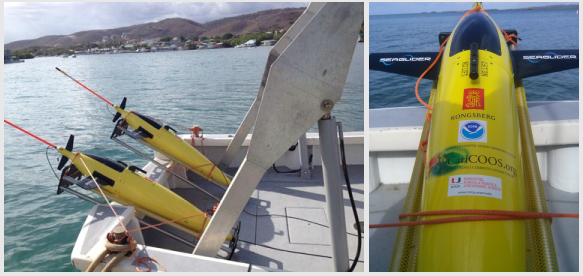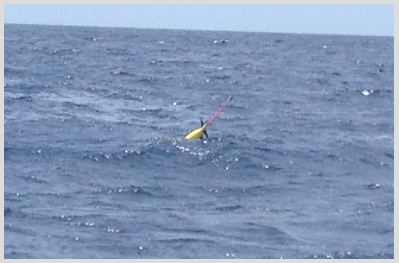Two Underwater Gliders Successfully Deployed off Puerto Rico
Two underwater gliders have been successfully deployed off Puerto Rico in the Caribbean Sea and in the North Atlantic Ocean during the week of July 14, 2014. These new observational platforms are part of the multi-institutional "Sustained and Targeted Ocean Observations with Underwater Gliders" Project, which is lead by AOML.
Scientists from the US National Oceanic and Atmospheric Administration (NOAA), the IOOS Caribbean Coastal Ocean Observing System (CariCOOS) at the University of Puerto Rico Mayaguez, the University of Miami, and the Maritime Authority of the Dominican Republic, formed a partnership to monitor the upper ocean thermal structure in areas of the Caribbean Sea and tropical North Atlantic Ocean using autonomous underwater vehicles called "gliders". The two gliders that are part of this project were deployed during the week of July 14th from the research vessel La Sultana of the University of Puerto Rico at Mayaguez.
Although scientists have been able to improve the forecast of hurricane tracks over recent years, the improvement of intensity forecasts has remained stagnant. "The lack of adequate ocean observations that better describe the heat contained in the ocean has been hypothesized to be a reason for this deficiency", says Gustavo Goni, an oceanographer of NOAA and investigator of this project. The goal of this research will be to assess the impact of these glider observations in hurricane intensity forecast models. The underwater gliders are durable, and autonomous vehicles powered by battery that will be remotely piloted by NOAA scientists until the end of the ongoing hurricane season. These gliders will traverse two regions where hurricanes often intensify and will make repetitive dives as they descend and ascend back and forth, while carrying out measurements of temperature and salinity, weaving through the upper 1000 meters of the ocean. As the gliders reach the ocean surface at the end of each dive cycle they will transmit their data through satellite to scientists and forecasters.

These ocean observations are part of NOAA's Atlantic hurricane field program, which includes a suite of other ocean and atmospheric observations, some carried out by the hurricane hunter planes. "It is expected that the analysis of all of these data during the passage of a tropical cyclone will enable scientists to better understand the role that the ocean plays in hurricane intensification, and the importance of the cooling that these cyclones produce in the upper layers of the ocean", said Professor Julio Morell of the University of Puerto Rico at Mayaguez. This project will be carried out during the next two years and is expected to lead to further collaboration among the institutions participating in it, with its goals to also include additional environmental observations to improve our understanding of the ocean currents and ecosystems in the region.

Participants in the July deployments will like to thank the crew of the R/V La Sultana for their help and dedication: Capt. Ricky Laracuente, Capt. Cesar Carrero, Hugo Montalvo y Ubaldo Lopez
The web page for this project can be found here